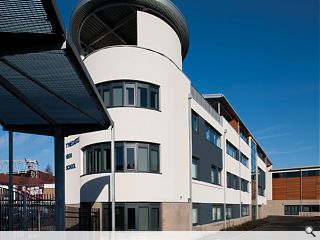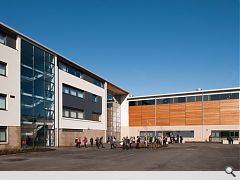Tynecastle High
31 May 2010
The UK school’s sector has long been mired in political imbroglio over class sizes, funding mechanisms and (in Scotland at least) sectarianism. In comparison to our African cousins however we don’t know how lucky we are, but are our schools necessarily better? Urban Realm tours Edinburgh’s latest school to find out.
Tynecastle High is a new school with a proud history, prominently sited within the inner city Gorgie district of Edinburgh. It lies across the road from Hearts ground and succeeds a 100 year old building across the road, a building whose fabric harks back to a time before the computer was even invented, much less provided for you.Mike Scott, the school’s business manager speculates: “When the school first opened it probably didn’t have any electricity in it. There’s certainly evidence that there were gas lights and old fireplaces that had been boarded up”. Honouring that history was a priority the design team were at pains to implement and a recurring design element that would crop up throughout our tour. The school’s main entrance is flanked by a pair of cylindrical towers, a somewhat incongruous site and a deliberate design choice. “We’re in an area called Tynecastle, there was almost a joke we had at one stage when I said ‘how about Tynecastle’s?’ We haven’t got the crenellations on top of our ‘turrets’ and we haven’t got the flags but nevertheless it was a template and I think it works.” The effect is heightened by low eaves detail and a set back around the upper floor to respect adjacent tenements and avoid overshadowing.
“This is not a clean slate” stresses Scott, pointing to a stained glass window, part of the reason why the existing school was a listed building. “We weren’t able to bring the real thing with us but we were able to bring a digitally window cleaned representation round.” Such continuity is reflected in the recounted tale of former Tynecastle student Thomas Hunter who led a solo charge against German positions toward the end of WWII, netting himself a bullet in the head and a Victoria Cross for his troubles. “He got killed” laments Scott, pointing towards the historic dux board upon the wall in which the Hunter name takes pride of place. “But that’s the sort of history we continue to celebrate because there aren’t many of them about.” This veneration of past exploits has not inhibited the school from pursuing more contemporary approaches, such as an innovative collaboration with a nearby distillery, effectively a miniature power station and cooling tower. “It was costing them money to cool the heat down and they were getting wellied on carbon taxes”, Scott reveals. “Now it goes through an exchanger to power the school’s underfloor heating system.” “You can’t rely on the fact that we’ll have that heat because the distillery will close at Christmas and New Year” interjects Ryan Tennyson of architects Aedas however: “We still have a school to heat at these times so we do have a boiler room”.
Tennyson was responsible for overseeing the design of the school, stipulating a decluttered approach to internal spaces through removal of ducts to draw in light and utilising colour to dilute signage. “The brief was quite specific in terms of the function and plan of the building but not the aesthetics. For us it was quite challenging at times because of the cost aspect and cladding materials. We had looked at Trespa cladding and I would have preferred the steel work not to have been so value engineered, it feels heavy. But with PPP there’s a cost issue, contractors are always pushing for efficiencies.” This saw the team opt for a palette that included buff brick, Siberian larch and insulated light and dark render, carefully selected from sample panels to ensure the two wouldn’t bleed.
‘triiiiiiiiiiiiiiiiiiiiiiiinggg’
“This is great!” shouts Scott amidst the sudden cacophony “watch the kids here,” gesticulating toward a double barrelled staircase: “The two things the architect got sick of hearing about were Fred Astaire and Ginger Rogers, you know the sort of sweeping staircase that goes up and round like on the Titanic? I had one of them in the original school and I said look, never mind this modern crap. I want something that brings that history across, not in an old fashioned form but by taking that metaphor and building it in today’s context.” For the disabled and lethargic stair dodgers there is however a lift. We call it up. “The lift isn’t swabbed, we decided should we lock it or not and we thought no.
A couple of students tried it on to get in the lift and they get caught and the process of education works very quickly.” Says Scott, ominously. This is an important architectural accessory, remarks Mike stepping out of the lift and picking up an unassuming plastic bucket. “This is Mrs Primrose the art teacher’s personal pot”, this particular accessory is used for wedging the door to a rooftop terrace open. “Otherwise the door will catch and we’ll have to use the fire escape to get down” explains Scott with the frank air of personal experience. The door in question leads to an outdoor ‘art terrace’ but thus far hasn’t seen much use: “I’m not willing with a bunch of lovely 2nd years to use my bucket as the only way of getting in and out if some smart alec removes the bucket and there’s no way of me getting back in the door.” Explains Mrs Primrose, adding to Tennyson: “You didn’t get me the Jacuzzi.”
Bucket duly lodged we venture forth into an expansive, if barren, space. Scott sells it: “You could get some seating here, this is south facing so the sun does a complete arc across the sky. The great thing about this terrace is the view, I used to say the kids before would spend six years at art class and be able to paint a blue sky and a grey sky, or a blue sky with a seagull. Now we have these great landscapes of the castle, Hearts and Murrayfield to inspire.” It’s certainly an assault on the senses, an effect heightened by the sweetly aroma of fermenting yeast wafting by providing a unique 4D olfactory experience.
Indeed a tight triangular site has forced Aedas to think in three dimensions here, making use of ordinarily redundant roofspace in innovative ways: “The site is 1.6 times bigger than our old site but that point 6 is more than taken up by a full size pitch, the question is how do you fit the rest of the school in? Where do you normally expect to find a greenhouse?” Quizzes Scott, “the garden? Well how about the third floor of a High School, the highest one in Gorgie,” as Scott delivers his coup de gras swinging open the door to an improbably lofty “plant” room.
Returning to the four storey atrium Scott motions toward the carrying sound of music: “In our old school common room the furniture was graffiti’d and trashed every year, so we thought lets have it open plan as a combination of cafeteria and work place. The whole intention is to use the environment in such a way as to suggest that 6th years are responsible enough to study at the library but also become responsible citizens. We want them to be part of the school management if you like, rather than sitting in this black hole of Calcutta doing unspeakable things.” What really catches the eye though are a series of Siberian Larch louvres, “Paul Zanre got quite excited by that,” says Tennyson.”It has three dimensions to it, you can see the redness in it, that’s a natural state that you don’t expect from the larch.” “I would have guessed in the time we’ve been walking round that two trains have gone past and you just don’t hear them,” cites Tennyson proud of the acoustic qualities of his school.
“The main east coast rail route passes by on an embankment to the west and that is why the PE and music departments were placed between. You don’t want the vibrations filtering through and out, it’s about mutual respect.” Scott chips in: “Rather than a kid blowing a bugle horn during lessons we thought we would address that deficiency, they are ‘weapons of mass percussion’. Instead a series of custom built recording studios and sound rooms provide facilities that would put EMI to shame, allowing the school’s orchestra and wind band to do their work. A tour of the playground proved less fun however, a space where crisp pokes spiral listlessly, carried on invisible vortices of air trapped within the high walls of the compound, sort of like the melancholy scene in American Beauty, minus the beauty. Scott wisely sits this one out.
“Landscape is in the process of bedding in” defends Tennyson, surveying the barren domain of asphalt. Re-affirming that landscaping was not the work of Aedas, we observe clumps of bare earth in process of weathering into the playground. Safely back indoors Scott picks up the baton: “One thing I’ve noticed is that the better the environment is the more the kids respect it, pupils are not used to having very good premises, that’s the sad thing. They were saying ‘we don’t deserve this’, it’s quite humbling to hear them say that.” Recounting one eye opening tale the schools business manager regaled: “Groups of girls were grabbing boys and dragging them into the toilets, I asked what on earth they were doing and they said ‘we had to show them these toilets, they’re even better than the Gyle!’”
Images taken by Paul Zanre.
|
|
Read next: Malawi Schools
Read previous: Rock the Casbah
Back to May 2010
Browse Features Archive
Search
News
For more news from the industry visit our News section.
Features & Reports
For more information from the industry visit our Features & Reports section.





